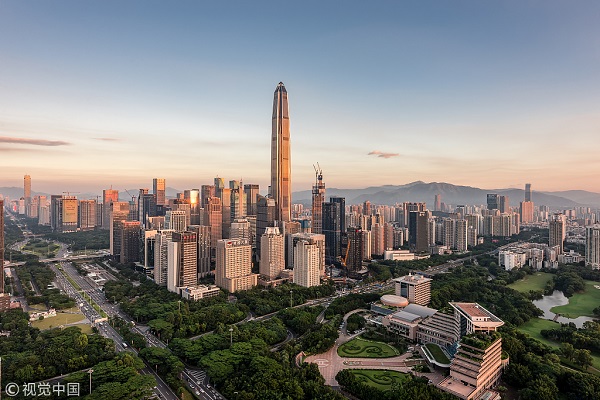Pan-Pearl River Delta
govt.chinadaily.com.cn Updated: Oct 18, 2018

Brief Introduction:
The Pan-Pearl River Delta region includes Fujian, Jiangxi, Hunan, Guangdong, Hainan, Sichuan, Guizhou and Yunnan provinces, Guangxi Zhuang autonomous region, Hong Kong and Macao SARs, which hereinafter are refered to as "9+2". After more than ten years of development, the Pan-Pearl River Delta region has become one of the most dynamic in China's economy.
Since 2003 when the Pan-Pearl River Delta regional cooperation was initiated by Guangdong province, it has been actively responded to and promoted by the 11 governments and has attracted widespread attention from all sectors and won wide approval.
Under the guidance of the central government, the Pan-Pearl River Delta regional cooperation is beginning to show results and is steadily advancing with the support of the relevant State departments and through the joint efforts of the governments.
The Pan-Pearl River Delta accounts for 1/5 of the country's area, 1/3 of its population and more than 1/3 of its economy (excluding the Hong Kong SAR and Macao SAR). The region has a long history of economic exchanges based on different areas’ complementary characteristics.
The Pan-Pearl River Delta regional cooperation operates within the framework of the Closer Economic Partnership Arrangement (CEPA). In accordance with the overall requirements of the national economic and social development plan, the Pan-Pearl River Delta adheres to regional coordinated and sustainable development, gives full play to the advantages and characteristics of all parties in the spirit of mutual respect, voluntariness and mutual benefits. Based on market principles, the region broadens fields of cooperation, improves levels of cooperation, and forms a pattern of cooperation and interaction based on complementary advantages and resulting in mutual benefit, win-win results and common development.
The two major platforms for Pan-Pearl River Delta regional cooperation are the Pan-Pearl River Delta Regional Cooperation and Development Forum and the Pan-Pearl River Delta Regional Cooperation and Development Trade Fair.
Strategic Development Plan:
The State Council approved Guidelines of the State Council on Deepening Cooperation in Pan-Pearl River Delta Region in March 2016 to promote the development of Pan-Pearl River Delta regional cooperation to a higher level and a wider range.
The Guidelines point out that in order to build a Pan-Pearl River Delta region with economic prosperity, social harmony and good ecology, from the conceptual point of view we should adhere to innovation, coordination, environmental-friendliness, openness, sharing, mutual benefit and win-win results. From the system point of view, we should improve the cooperative development mechanism and accelerate the establishment of a more fair and open market system. From the action point of view, it’s necessary to deepen reform and open wider to the outside world, promote the construction of the Pearl River-Xijiang River Economic Belt and major trans-province (autonomous region) cooperation platforms and integrate the nine provinces (autonomous region) in the mainland while deepening cooperation between the nine provinces (autonomous region) and Hong Kong and Macao.
The Guidelines put forward eight key tasks on deepening regional cooperation in the Pan-Pearl River Delta:
First, promote regional economic cooperation and build a regional economic zone, with Guangdong, Hong Kong and Macao at the center and the Pearl River-Xijiang River Economic Belt as the hinterland; we can expect this to drive the development of central, south and southwest regions and influence the economies of Southeast Asia and South Asia.
Second, promote the construction of a unified market, implement unified market rules and build a regional social credit cooperation system and regional customs clearance system.
Third, integrate major infrastructure, build a comprehensive modern transportation system and an energy supply guarantee system, improve the water conservancy infrastructure system, and accelerate upgrading of regional network infrastructure.
Fourth, promote regional innovation-driven development, strengthen regional scientific and technological innovation cooperation, build a regional collaborative innovation system and optimize the regional innovation environment.
Fifth, strengthen cooperation in social undertakings, education, culture, health care, human resources and social security, tourism, and social governance.
Sixth, jointly cultivate the new advantages of opening to the outside world, continue the construction of "the Belt and Road", give full play to the demonstration and leading role of the free trade test zone, and promote the construction of ports and special areas.
Seventh, jointly promote the construction of ecological civilization, strengthen the protection of water resources and water environment in trans-provincial river basins, and the comprehensive management of air pollution, and improve coordinated protection and management of ecological environment.
Eighth, give full play to the special role of Hong Kong and Macao and promote multi-level cooperation and exchanges between them and the mainland in major infrastructure and cooperation platforms, industries and social affairs.
The Guidelines put forward the following safeguard measures to deepen regional cooperation in the Pan-Pearl River Delta:
First, the relevant departments of the State Council must strengthen the guidance and service for the regional cooperation in the Pan-Pearl River Delta, and the people's governments of the nine provinces (autonomous region) in the mainland should strengthen organizational leadership, improve the working mechanisms, carry out their responsibilities and work together with Hong Kong and Macao to prepare a cooperative development plan.
Second, innovate and improve the cooperation mechanism, give full play to the role of the joint meeting of executive heads, and expand the influence of the Pan-Pearl River Delta Regional Cooperation and Development Forum.
Third, establish a cooperative fund guarantee mechanism and a Pan-Pearl River Delta regional cooperative development fund, promote the Public-Private Partnership (PPP) cooperation model, and support the involvement of developmental financial institutions.
Investment Advantages:
Upgrading of industrial structure
The Pearl River Delta has attracted a large number of high-tech enterprises and high-tech product production enterprises, initially forming a high-tech industrial zone dominated by electronic information, new materials, biomedicine and optomechatronics and showing the trends in industrial upgrading. On the east coast of the Pearl River, the industries of Guangzhou, Dongguan and Shenzhen have experienced rounds of upgrading and formed a famous national high-tech industrial belt.
Concentration of foreign investment
According to a survey report by the American Chamber of Commerce in Guangdong and the Hong Kong Trade Development Council, 75 % of foreign-invested enterprises in Guangdong would choose the Pearl River Delta as their first choice for reinvestment. Guangdong's foreign investment driven economy leads the whole country, and Hong Kong, Macao and Taiwan enterprises' industrial output accounts for 60 % of that of all foreign-invested enterprises. A foreign investment driven economy has solved the original accumulation problem of industrialization for Guangdong Province.
Maturity of urban agglomeration
As the frontier of reform and opening up, Shenzhen's political system reform will first play a role in the Pearl River Delta. Geographically, the Pearl River Delta has initiated economic cooperation with Hong Kong, Macao and Southeast Asia; its resource integration and coordination is more efficient than that of one city and two provinces in the Yangtze River Delta, and its adjustment and upgrading of industrial structure is also faster than that process in the Yangtze River Delta.
High system competitiveness
The competitive level is due to the Pearl River Delta’s proximity to Hong Kong, which has become a source of investment, technology, information, management, international connections, access to foreign companies and market knowledge. Through its docking with Hong Kong, the Pearl River Delta is well connected to the international market and has established an international market-oriented industry, attracting workers, scientists and engineers from all over China. Its economic vitality depends largely on the development of the market and the private sector.
![]()





